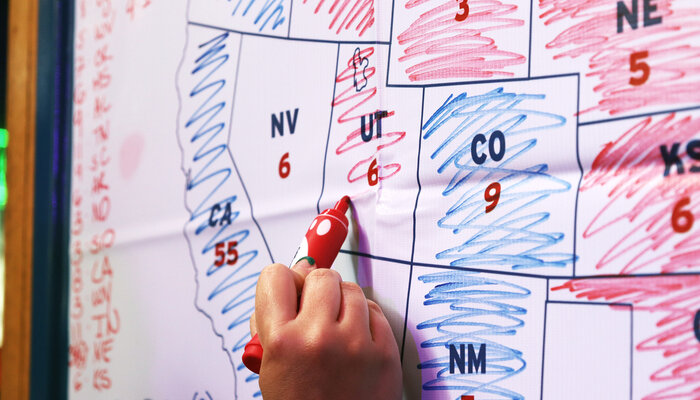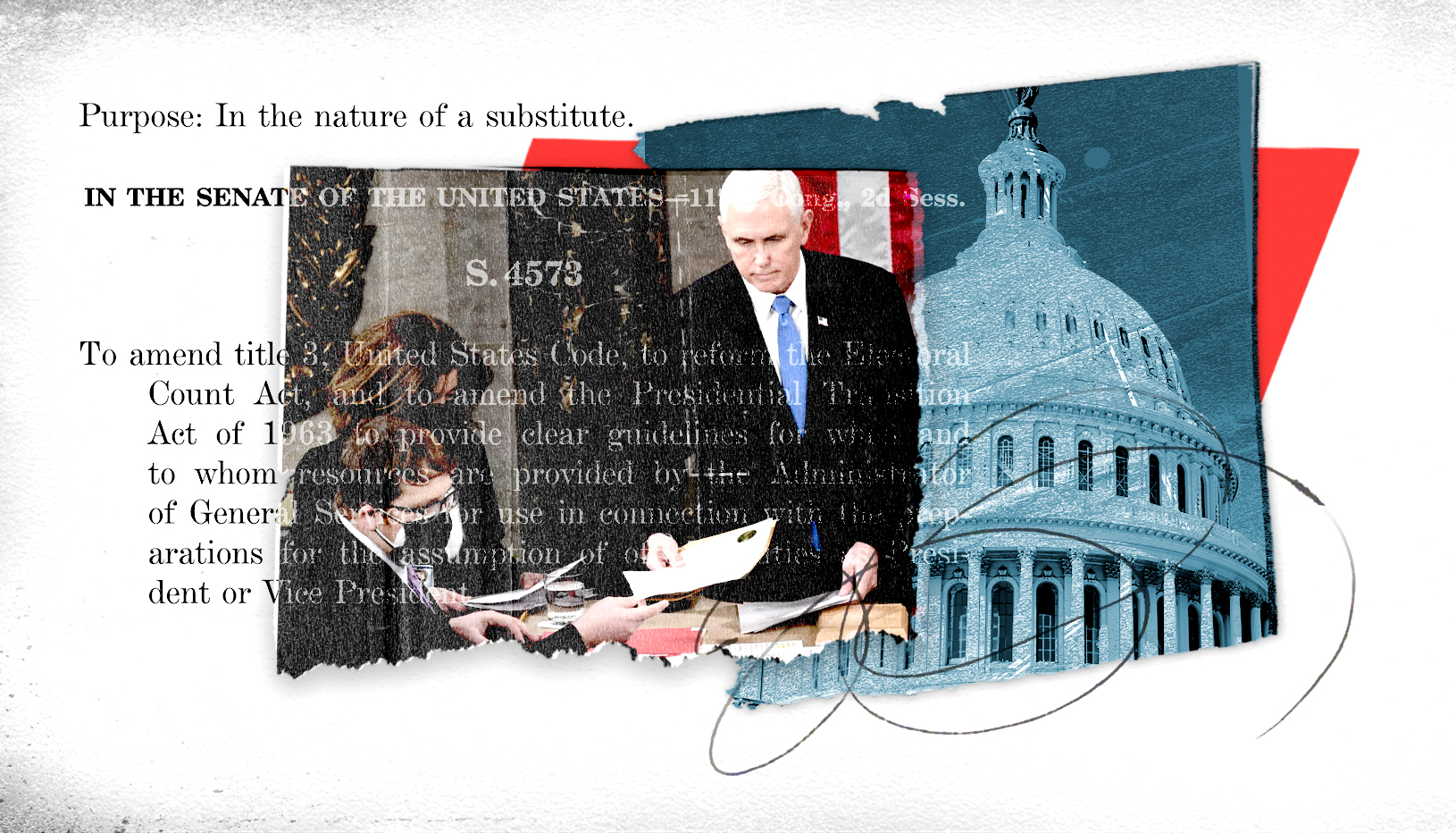In the United States, the presidency is decided not by the national popular vote but by the Electoral College — an outdated and convoluted system that sometimes yields results contrary to the choice of the majority of American voters. On five occasions, including in two of the last six elections, candidates have won the Electoral College, and thus the presidency, despite losing the nationwide popular vote.
The Electoral College has racist origins — when established, it applied the three-fifths clause, which gave a long-term electoral advantage to slave states in the South — and continues to dilute the political power of voters of color. It incentivizes presidential campaigns to focus on a relatively small number of “swing states.” Together, these dynamics have spurred debate about the system’s democratic legitimacy.
To make the United States a more representative democracy, reformers are pushing for the presidency to be decided instead by the national popular vote, which would help ensure that every voter counts equally.
What is the Electoral College and how does it work?
The Electoral College is a group of intermediaries designated by the Constitution to select the president and vice president of the United States. Each of the 50 states is allocated presidential electors equal to the number of its representatives and senators. The ratification of the 23rd Amendment in 1961 allowed citizens in the District of Columbia to participate in presidential elections as well; they have consistently had three electors.
In total, the Electoral College comprises 538 members. A presidential candidate must win a majority of the electoral votes cast to win — at least 270 if all 538 electors vote.
The Constitution grants state legislatures the power to decide how to appoint their electors. Initially, a number of state legislatures directly selected their electors, but during the 19th century they transitioned to the popular vote, which is now used by all 50 states. In other words, each awards its electoral votes to the presidential candidate chosen by the state’s voters.
Forty-eight states and the District of Columbia use a winner-take-all system, awarding all of their electoral votes to the popular vote winner in the state. Maine and Nebraska award one electoral vote to the popular vote winner in each of their congressional districts and their remaining two electoral votes to the statewide winner. Under this system, those two states sometimes split their electoral votes among candidates.
In the months leading up to the general election, the political parties in each state typically nominate their own slates of would-be electors. The state’s popular vote determines which party’s slates will be made electors. Members of the Electoral College meet and vote in their respective states on the Monday after the second Wednesday in December after Election Day. Then, on January 6, a joint session of Congress meets at the Capitol to count the electoral votes and declare the outcome of the election, paving the way for the presidential inauguration on January 20.
How was the Electoral College established?
The Constitutional Convention in 1787 settled on the Electoral College as a compromise between delegates who thought Congress should select the president and others who favored a direct nationwide popular vote. Instead, state legislatures were entrusted with appointing electors.
Article II of the Constitution, which established the executive branch of the federal government, outlined the framers’ plan for the electing the president and vice president. Under this plan, each elector cast two votes for president; the candidate who received the most votes became the president, with the second-place finisher becoming vice president — which led to administrations in which political opponents served in those roles. The process was overhauled in 1804 with the ratification of the 12th Amendment, which required electors to cast votes separately for president and vice president.
How did slavery shape the Electoral College?
At the time of the Constitutional Convention, the northern states and southern states had roughly equal populations. However, nonvoting enslaved people made up about one-third of the southern states’ population. As a result, delegates from the South objected to a direct popular vote in presidential elections, which would have given their states less electoral representation.
The debate contributed to the convention’s eventual decision to establish the Electoral College, which applied the three-fifths compromise that had already been devised for apportioning seats in the House of Representatives. Three out of five enslaved people were counted as part of a state’s total population, though they were nonetheless prohibited from voting.
Wilfred U. Codrington III, an assistant professor of law at Brooklyn Law School and a Brennan Center fellow, writes that the South’s electoral advantage contributed to an “almost uninterrupted trend” of presidential election wins by southern slaveholders and their northern sympathizers throughout the first half of the 19th century. After the Civil War, in 1876, a contested Electoral College outcome was settled by a compromise in which the House awarded Rutherford B. Hayes the presidency with the understanding that he would withdraw military forces from the Southern states. This led to the end of Reconstruction and paved the way for racial segregation under Jim Crow laws.
Today, Codrington argues, the Electoral College continues to dilute the political power of Black voters: “Because the concentration of black people is highest in the South, their preferred presidential candidate is virtually assured to lose their home states’ electoral votes. Despite black voting patterns to the contrary, five of the six states whose populations are 25 percent or more black have been reliably red in recent presidential elections. … Under the Electoral College, black votes are submerged.”
What are faithless electors?
Ever since the 19th century reforms, states have expected their electors to honor the will of the voters. In other words, electors are now pledged to vote for the winner of the popular vote in their state. However, the Constitution does not require them to do so, which allows for scenarios in which “faithless electors” have voted against the popular vote winner in their states. As of 2016, there have been 90 faithless electoral votes cast out of 23,507 in total across all presidential elections. The 2016 election saw a record-breaking seven faithless electors, including three who voted for former Secretary of State Colin Powell, who was not a presidential candidate at the time.
Currently, 33 states and the District of Columbia require their presidential electors to vote for the candidate to whom they are pledged. Only 5 states, however, impose a penalty on faithless electors, and only 14 states provide for faithless electors to be removed or for their votes to be canceled. In July 2020, the Supreme Court unanimously upheld existing state laws that punish or remove faithless electors.
What happens if no candidate wins a majority of Electoral College votes?
If no ticket wins a majority of Electoral College votes, the presidential election is sent to the House of Representatives for a runoff. Unlike typical House practice, however, each state only gets one vote, decided by the party that controls the state’s House delegation. Meanwhile, the vice-presidential race is decided in the Senate, where each member has one vote. This scenario has not transpired since 1836, when the Senate was tasked with selecting the vice president after no candidate received a majority of electoral votes.
Are Electoral College votes distributed equally between states?
Each state is allocated a number of electoral votes based on the total size of its congressional delegation. This benefits smaller states, which have at least three electoral votes — including two electoral votes tied to their two Senate seats, which are guaranteed even if they have a small population and thus a small House delegation. Based on population trends, those disparities will likely increase as the most populous states are expected to account for an even greater share of the U.S. population in the decades ahead.
What did the 2020 election reveal about the Electoral College?
In the aftermath of the 2020 presidential race, Donald Trump and his allies fueled an effort to overturn the results of the election, spreading repeated lies about widespread voter fraud. This included attempts by a number of state legislatures to nullify some of their states’ votes, which often targeted jurisdictions with large numbers of Black voters. Additionally, during the certification process for the election, some members of Congress also objected to the Electoral College results, attempting to throw out electors from certain states. While these efforts ultimately failed, they revealed yet another vulnerability of the election system that stems from the Electoral College.
The Electoral Count Reform Act, enacted in 2023, addresses these problems. Among other things, it clarifies which state officials have the power to appoint electors, and it bars any changes to that process after Election Day, preventing state legislatures from setting aside results they do not like. The new law also raises the threshold for consideration of objections to electoral votes. It is now one-fifth of each chamber instead of one senator and one representative. Click here for more on the changes made by the Electoral Count Reform Act.
What are ways to reform the Electoral College to make presidential elections more democratic?
Abolishing the Electoral College outright would require a constitutional amendment. As a workaround, scholars and activist groups have rallied behind the National Popular Vote Interstate Compact (NPV), an effort that started after the 2000 election. Under it, participating states would commit to awarding their electoral votes to the winner of the national popular vote.
In other words, the NPV would formally retain the Electoral College but render it moot, ensuring that the winner of the national popular vote also wins the presidency. If enacted, the NPV would incentivize presidential candidates to expand their campaign efforts nationwide, rather than focus only on a small number of swing states.
For the NPV to take effect, it must first be adopted by states that control at least 270 electoral votes. In 2007, Maryland became the first state to enact the compact. As of 2019, a total of 19 states and Washington, DC, which collectively account for 196 electoral votes, have joined.
The public has consistently supported a nationwide popular vote. A 2020 poll by Pew Research Center, for example, found that 58 percent of adults prefer a system in which the presidential candidate who receives the most votes nationwide wins the presidency.





